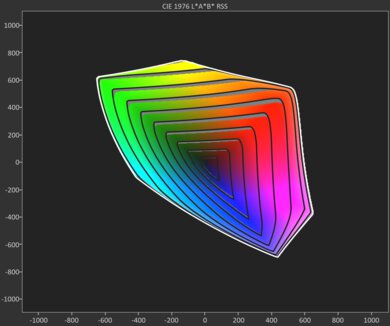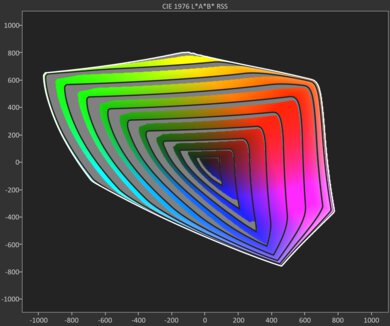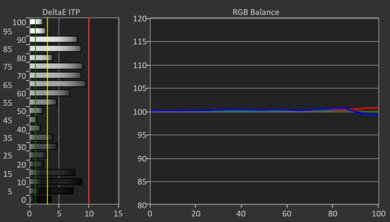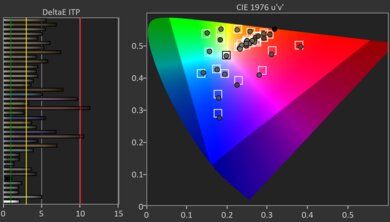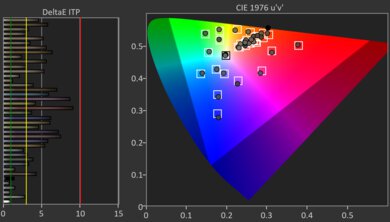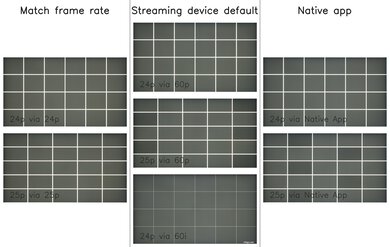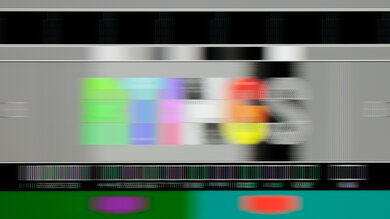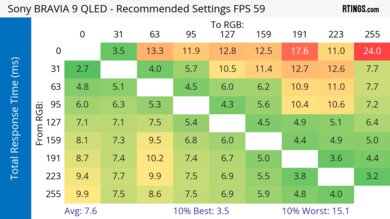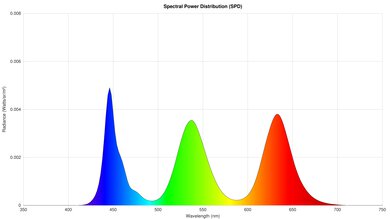The Sony BRAVIA 9 QLED is Sony's flagship TV in 2024 and is their first non-OLED flagship model since 2020. It sits above the Sony BRAVIA 7 and the Sony BRAVIA 8 OLED. Sony claims they've developed the smallest LED controllers on the market, allowing for better contrast and more precise control of local dimming zones to greatly reduce the blooming around bright, small objects that LED TVs with local dimming typically have. One of Sony's main goals with the TV is to bring unity with their BVM-HX3110 mastering monitor, used in post-production to master films. They want the director's vision to translate to the at-home movie-watching experience as well as possible.
The TV is packed with modern features like Dolby Vision, HDMI 2.1 bandwidth, up to 4k @ 120Hz, and VRR support. It uses the Google TV interface, which is loaded with apps and has other smart features like voice control. The TV has a built-in 70W 2.2.2 channel speaker system, and you can also use the TV as a center channel with compatible soundbars and receivers. We bought and tested the 65-inch model, but it's available in three sizes: 65-inch, 75-inch, and 85-inch.
Our Verdict
The Sony BRAVIA 9 is great for mixed usage. It really excels in reference conditions like a home theater due to its excellent black levels, impressive colors, solid accuracy, and HDR brightness capabilities. You also get top-tier image processing that makes DVDs, cable broadcasts, and compressed streams look good. This TV also performs very well in a bright room thanks to its superb SDR brightness, but it does struggle a bit with direct reflections. The TV is good for gaming, mostly due to its overall image quality, but it does struggle with displaying sharp motion, and its input lag is higher than similar models from other brands. Finally, it has a wide enough viewing angle for watching content with a couple of friends, but since the image degrades from more aggressive angles, it's not good for large seating arrangements.
Amazing black levels with barely any blooming.
Amazing HDR brightness for impactful highlights.
Superb SDR brightness helps it overcome glare from indirect lighting.
Exceptional upscaling and low-quality content smoothing.
Colors are vibrant, lifelike, bright, and accurate.
Struggles with reflections from direct sources of light.
Slow pixel transitions in Game Mode leads to blurry motion.
The Sony BRAVIA 9 is an amazing option for your home theater. It has excellent black levels that are approaching OLED status, so you get incredibly deep blacks with almost no visible blooming around bright elements. It's also exceptionally bright in HDR, so highlights really stand out in HDR movies and shows. Colors are also vibrant and lifelike with minimal banding, and the TV has top-notch accuracy that is sure to impress purists; this isn't a TV that requires calibration. Furthermore, you get Sony's excellent image processing, so it upscales and cleans up low-bitrate content with ease, leaving you with a clean-looking image regardless of the content. However, there's some noticeable stutter during slow camera movements due to the TV's fast response time, but not everyone will notice this, and it's not quite as bad as it is on OLEDs.
Amazing black levels with barely any blooming.
Amazing HDR brightness for impactful highlights.
Exceptional upscaling and low-quality content smoothing.
Colors are vibrant, lifelike, bright, and accurate.
Excellent PQ EOTF tracking means HDR content has accurate brightness.
The Sony BRAVIA 9 is excellent for use in a bright room. It has superb SDR brightness and good handling of indirect reflections, so it easily overcomes glare in bright rooms, with one exception. Unfortunately, the TV only has adequate direct reflection handling, so lamps or windows opposite the TV are visible on the screen and are quite distracting. On the other hand, it does a good job retaining color vibrancy in a bright room, and although black levels do raise in a bright room, blacks remain deep enough that the image doesn't look washed out.
Superb SDR brightness helps it overcome glare from indirect lighting.
Colors are vibrant, lifelike, bright, and accurate.
Struggles with reflections from direct sources of light.
The Sony BRAVIA 9 is excellent for watching sports. This TV is very bright and has the reflection handling to overcome glare in a bright room, but it does struggle more with direct reflections, so it's best to avoid placing the TV opposite a window or lamp. Colors in your favorite sports are nice and vibrant thanks to the TV's impressive colors. You get a clean-looking image when watching cable broadcasts and compressed streams thanks to the TV's excellent image processing, and motion is clear thanks to its fast response time. The TV's viewing angle is alright, so it's good if you watch the game with a couple of friends, but it's not wide enough for larger groups, as the image degrades when viewed from more aggressive angles. Unfortunately, the TV's gray uniformity isn't the best, so you do see some dirty screen effect when watching sports with large areas of uniform color.
Superb SDR brightness helps it overcome glare from indirect lighting.
Exceptional upscaling and low-quality content smoothing.
Colors are vibrant, lifelike, bright, and accurate.
Struggles with reflections from direct sources of light.
Some noticeable dirty screen effect towards the center of the screen.
The Sony BRAVIA 9 is good for gaming, especially when it comes to image quality. It has excellent blacks levels with almost no visible blooming, vibrant colors that pop, and the HDR brightness needed for an impactful experience when playing HDR games. The TV has HDMI 2.1 bandwidth on two ports for up to 4k @ 120Hz with VRR. However, its pixel transitions are quite slow overall, so fast motion in games is blurry. Although the TV has low enough input lag for single-player campaigns and casual gaming, it's higher than competing models from other brands, so it's not the best option for competitive gamers.
Amazing HDR brightness for impactful highlights.
- HDMI 2.1 bandwidth, up to 4k @ 120Hz, and VRR support.
Colors are vibrant, lifelike, bright, and accurate.
Higher input lag than competing models.
- Only supports 4k @ 120Hz on two ports.
Slow pixel transitions in Game Mode leads to blurry motion.
The Sony BRAVIA 9 has outstanding brightness overall. It has superb SDR brightness, so it's more than capable of overcoming glare from indirect sources of light. It also has excellent HDR brightness, which makes highlights really pop in HDR content.
Amazing HDR brightness for impactful highlights.
Superb SDR brightness helps it overcome glare from indirect lighting.
The Sony BRAVIA 9 has excellent black levels. It has incredibly effective local dimming, giving it amazing contrast and very good black uniformity with almost no visible blooming.
Amazing black levels with barely any blooming.
The Sony BRAVIA 9 has impressive colors. It has outstanding color volume in HDR and good color volume in SDR, so colors are bright and impactful no matter the content. Furthermore, this is an exceptional TV when it comes to color accuracy, so it doesn't require calibration if you care about the content creator's intent.
Colors are vibrant, lifelike, bright, and accurate.
Note: We're in the process of improving our tests related to image processing, but this score should give you a general idea of how a TV performs overall with its image processing capabilities.
The Sony BRAVIA 9 has amazing image processing overall. It upscales low-resolution content very well, and it does a great job removing artifacts from low-bitrate content. Furthermore, there's very little banding in color gradients, and the brightness of HDR content is very accurate.
Exceptional upscaling and low-quality content smoothing.
Excellent PQ EOTF tracking means HDR content has accurate brightness.
Very little banding in color gradients.
The Sony BRAVIA 9 has just okay responsiveness in Game Mode. It supports VRR for a nearly tear-free gaming experience, but its input lag is higher than competing models, so it's not the best option for PVP games. Unfortunately, the TV's pixel transitions are quite slow, so there is noticeable blur behind fast motion.
- HDMI 2.1 bandwidth, up to 4k @ 120Hz, and VRR support.
Higher input lag than competing models.
- Only supports 4k @ 120Hz on two ports.
Slow pixel transitions in Game Mode leads to blurry motion.
We're in the process of fixing the way we evaluate a TV's overall motion handling. This section is currently broken, and the score isn't indicative of how well a TV handles motion overall.
Performance Usages
Changelog
-
Updated Oct 21, 2025:
We bought and tested the TCL QM9K and added a comparison in the PQ EOTF Tracking section.
-
Updated Oct 21, 2025:
This review has been updated to Test Bench 2.1. We wrote text for the newly added Micro-Judder test, refreshed the text in the updated Judder section, and tweaked the text in the renamed Response Time Stutter section.
- Updated Oct 21, 2025: We added text to the new Micro-Judder section and refreshed the text in the updated Judder and Response Time Stutter sections after converting the review to TV 2.1.
-
Updated May 29, 2025:
Mentioned the newly reviewed Sony BRAVIA 8 II OLED in the Contrast section.
Check Price
Differences Between Sizes And Variants
We bought and tested the 65-inch Sony BRAVIA 9, but it's also available in 75-inch and 85-inch sizes, and most of these results are valid for those sizes. The number of local dimming zones varies between sizes, so the contrast and dark room performance might be slightly different depending on which size you get. We expect the bigger sizes to have even better local dimming performance than the 65-inch. A Costco variant known as the Sony XR90C is also available in a 65-inch and 75-inch size. There's no difference in performance, but it has a longer warranty.
| Size | Model Number | Costco Model | Local Dimming Zones |
|---|---|---|---|
| 65" | K-65XR90 | K-65XR90C | 1512 |
| 75" | K-75XR90 | K-75XR90C | 1920 |
| 85" | K-85XR90 | - | 2808 |
Our unit was manufactured in May 2024, as seen on the label.
Popular TV Comparisons
The Sony BRAVIA 9 is an amazing TV and the best LED TV we've tested as of publication. Its black levels are approaching those found on OLEDs, it has Sony's top-tier image processing, impressive colors, and is very accurate across the board, all of which leads to an excellent home theater TV. If you're looking for a TV with amazing image quality but don't want an OLED, this is the TV to get. However, it does struggle more than its competitors when it comes to gaming performance. Despite having HDMI 2.1 bandwidth, 4k @ 120Hz, and VRR, its input lag is higher than competing models, and it has slow pixel transitions, which leads to blurry motion while gaming. It's also one of the most expensive TVs on the market, and you can get OLEDs with a much wider viewing angle and even better contrast for around the same price or even cheaper. Still, some people will prefer the BRAVIA 9's advantage in overall brightness.
For more options, check out our recommendations for the best TVs for watching movies, the best LED TVs, and the best TVs.
The Sony BRAVIA 9 is a bit brighter than the LG G5 OLED in SDR—especially on full-screen images—so it resists glare better for daytime TV, and its picture is more accurate out of the box. However, the LG matches or tops Sony's HDR highlight brightness in real scenes, pulls ahead in Game Mode, and its per-pixel dimming delivers perfect blacks with no blooming. LG also supports 4k @ 165Hz on every HDMI 2.1 port and offers lower input lag for competitive gaming, plus Dolby Vision. The Sony is usually a bit cheaper at the same size, but if price isn't a decisive factor, the LG's deeper contrast and strong gaming features make it the better all-around choice.
The Sony BRAVIA 9 is built for bright living rooms, pushing much higher full-screen bright scenes and SDR brightness than the Sony BRAVIA 8 II OLED, and its extra dimming zones rein in blooming better than earlier Sony FALD sets. Still, the OLED's classic strengths come through: the BRAVIA 8 II delivers flawless pixel-level blacks and wider viewing angles. Both TVs share Sony's XR processor, Dolby Vision, DTS passthrough, and solid motion interpolation, and both still top out at 4k @ 120Hz on their two full-bandwidth HDMI ports. If glare fighting and SDR punch matter most, the BRAVIA 9 is the safer pick; if you value perfect blacks, the BRAVIA 8 II is the more compelling option.
The Sony BRAVIA 8 OLED and the Sony BRAVIA 9 are better than each other in different ways. As impressive as the contrast and local dimming control on the BRAVIA 9 is, the BRAVIA 8 is an OLED, so it provides even deeper blacks with no blooming at all. The other main advantages of the BRAVIA 8's OLED panel are its nearly instantaneous response time and much wider viewing angle. However, the BRAVIA 9 has a big advantage when it comes to brightness: It is much brighter in SDR, so it overcomes glare in the brightest of rooms, and it's also much brighter in HDR, so it can take better advantage of HDR content that gets incredibly bright. On top of that, the BRAVIA 9 is more accurate in SDR and HDR.
The TCL QM8K and the Sony BRAVIA 9 are closely matched TVs. The TCL gets brighter, delivering brighter highlights in the rare content that can actually reach such high peaks. The TCL is also better for gaming, with lower input lag and support for higher refresh rates. That being said, if creative intent is important to you, the Sony is the better choice, as it delivers a much more accurate image under reference conditions.

We buy and test dozens of TVs yearly, taking an objective, data-driven approach to deliver results you can trust. Our testing process is complex, with hundreds of individual tests that take over a week to complete. Most of our tests are done with specially designed test patterns that mimic real content, but we also use the same sources you have at home to ensure our results match the real-world experience. We use two main tools for our testing: a Colorimetry Research CR-100 colorimeter and a CR-250 spectroradiometer.
Test Results

The Sony BRAVIA 9 has amazing HDR brightness. Highlights really pop out during darker scenes, and the TV is bright enough that very bright specular highlights even stand out in well-lit scenes. Combined with its exceptional contrast, this TV provides a very impactful HDR viewing experience with all HDR content.
These measurements are after calibrating the HDR white point with the following settings:
- HDR Picture Mode: Professional
- Brightness (HDR): Maximum
- Contrast (HDR): 90
- Color Temperature: Expert 2
- Peak Luminance: High
- Auto Local Dimming (HDR): High
- HDR Tone Mapping: Gradation Preferred
Results with Advanced Contrast Enhancer set to 'On':
- Hallway Lights: 948 cd/m²
- Yellow Skyscraper: 754 cd/m²
- Landscape Pool: 550 cd/m²
Setting local dimming to 'Medium' makes the TV a bit brighter overall than the 'High' setting, as seen in the results below.
- Hallway Lights: 867 cd/m²
- Yellow Skyscraper: 678 cd/m²
- Landscape Pool: 280 cd/m²
Most scenes are slightly dimmer in Game Mode, but it's not noticeable. Highlights still pop out during darker moments in games, and it's still bright enough that very bright specular highlights stand out in well-lit scenes. Combined with its exceptional contrast, this TV provides a very impactful HDR gaming experience.
These measurements are after calibrating the HDR white point with the following settings:
- HDR Picture Mode: Game
- Brightness (HDR): Maximum
- Contrast (HDR): 90
- Color Temperature: Expert 2
- Peak Luminance: High
- Auto Local Dimming (HDR): High
- HDR Tone Mapping: Gradation Preferred
The Sony BRAVIA 9 has superb SDR brightness and easily overcomes glare in even the brightest of rooms.
These measurements are after calibration with the following settings:
- Picture Mode: Professional
- Brightness (SDR): Maximum
- Contrast (SDR): 90
- Gamma (SDR): 0
- Color Temperature: Expert 1
- Peak Luminance: High
- Auto Local Dimming (SDR): High
The Sony BRAVIA 9 has amazing contrast. Its native contrast is alright, but with local dimming on 'High,' the TV's contrast ratio delivers incredibly deep blacks that are approaching those found on OLEDs like the Sony BRAVIA 8 II OLED. Blacks also stay deep when bright highlights are on screen.
With local dimming on 'Medium,' the TV is a bit brighter overall, but its contrast ratio drops to 184867:1.
The TV's lighting zone precision is outstanding with local dimming on 'High.' There's only a tiny bit of blooming around bright objects and subtitles when they're displayed against a black background. It's so subtle that it's barely noticeable with most content, but there's some noticeable blooming that bleeds into the black bars of letterboxed movies during very bright scenes. There's also more apparent blooming when watching the TV from an angle. Finally, there's considerable blooming across the entire screen if you open any settings menu, even when hitting the volume buttons on the remote.
Setting local dimming to 'Medium' makes the TV a bit brighter overall, but it does slightly increase the amount of blooming. You can also see how the TV looks with local dimming 'Off' to compare the blooming performance with different settings.
The TV has remarkable lighting zone transitions. The leading edge of bright and quick-moving objects is a bit dimmer, and there's some minor haloing, but neither of these are noticeable with most real content.
With local dimming set to 'Medium,' the TV is a bit brighter but has slightly more noticeable zone transitions, which can be seen in this video that compares the Off, Medium, and High settings in the Professional (top row) and Game (bottom row) picture modes.
There's no visible difference in dark scene performance when the TV is set to Game Mode with local dimming on 'High.' However, with local dimming set to 'Medium,' the TV's blooming and zone transitions (bottom row) are noticeably worse.
The TV's black uniformity is very good. With local dimming disabled, the screen is blueish and cloudy. With local dimming on 'High,' the blacks are deep and uniform across the screen, and there's only a tiny bit of blooming around bright objects on a dark background.
Setting local dimming to 'Medium' gives you a slightly brighter image, but the blooming on the cross is more noticeable.
The Sony BRAVIA 9’s SDR color volume is good overall. It has very good coverage of the DCI-P3 color space, only struggling a bit with some lighter shades of color. The TV’s coverage of the wider BT.2020 color space is noticeably worse, and it struggles a lot more with all colors.
| Volume ΔE³ | DCI-P3 Coverage |
BT.2020 Coverage |
|---|---|---|
| L10 | 89.62% | 67.13% |
| L20 | 91.45% | 69.13% |
| L30 | 91.05% | 69.11% |
| L40 | 90.10% | 70.10% |
| L50 | 89.07% | 69.76% |
| L60 | 88.13% | 68.75% |
| L70 | 87.78% | 65.60% |
| L80 | 87.02% | 62.60% |
| L90 | 86.42% | 62.04% |
| L100 | 87.39% | 79.78% |
| Total | 88.38% | 67.11% |
The TV has outstanding color volume. It displays a wide range of colors at high luminance levels, and dark, saturated colors are displayed well due to its exceptional contrast.
The Sony BRAVIA 9 has excellent SDR pre-calibration accuracy. The color temperature is close to perfect, and gamma is very close to our target of 2.2, but all scenes are displayed brighter than intended. The white balance is very good, but blues and reds are a bit overrepresented in most shades of gray. The color accuracy is fantastic, but whites are a bit inaccurate. Fortunately, there are only very minor inaccuracies in some other colors.
The TV has even better SDR accuracy after calibration. The white balance, gamma, and color temperature are essentially perfect. Color accuracy is even better, and inaccuracies in whites are mostly gone. Other colors are still slightly off, but they're close enough that it's not noticeable with real content.
See our full calibration settings.
The Sony BRAVIA 9 has exceptional accuracy in HDR before calibration. There are some minor inaccuracies with white balance in some darker and brighter shades of gray, which makes the TV's color temperature a touch too cool, but it's still very close to 6,500K. Color accuracy is outstanding overall, but there are some very slight inaccuracies with reds. However, even the most ardent color purists likely won't notice these small mapping errors. This is a TV that's incredibly accurate out of the box, so calibration isn't necessary for most people.
After calibration, the TV is a bit more accurate in HDR. White balance is a bit better now, which brings its color temperature even closer to 6,500K. Color accuracy is mostly unchanged, but the minor mapping errors with reds have been reduced.
The Sony BRAVIA 9 has excellent PQ EOTF tracking. The TV tracks the curve incredibly close, besides some shadows and midtones being slightly too dark and some highlights being slightly too bright. The TV is bright enough to display content mastered at 600 and 1000 nits, so no roll-off is necessary. With content mastered at 4000 nits, the gradual roll-off near the TV's maximum brightness helps to preserve details in specular highlights. Although it's not as bright as many other high-end TVs like the TCL QM9K, it's far more accurate, delivering brightness much closer to what the content creator intended.
The TV does an exceptional job with upscaling low-resolution content like DVDs, standard definition cable channels, or lower-resolution streams. Details are well-defined and clear enough, but very fine details and small hard-coded text are a bit hard to make out.
Sharpness processing was calibrated with no over-sharpening for low-resolution content, with the following settings:
- Sharpness: 60
- Reality Creation: Auto
The TV has impressive HDR native gradient handling. There's noticeable banding in brighter blues, but all other colors have minimal or no banding at all.
This TV has decently low input lag when set into Game Mode, which ensures a responsive gaming experience. It's worth noting that despite the TV having low enough input lag that you don't feel any major delay with your inputs while gaming, it's a bit higher than most higher-tier models from other manufacturers.
Outside of game mode, the TV's input lag is much higher, and there's a noticeable delay when hitting buttons on the remote, like when pausing a movie.
The Sony BRAVIA 9 supports all common resolutions up to 4k @ 120Hz on two of its four HDMI ports. Chroma 4:4:4 signals are displayed properly with all supported resolutions when the TV's 'Content Type' is set to Game or PC, which is important for text clarity. Unfortunately, the TV doesn't support 1440p.
The Sony BRAVIA 9 supports HDMI Forum VRR and G-SYNC but doesn't support FreeSync. It works well across a wide refresh rate range and supports sources with Low-Frame-Compensation (LFC), which ensures your games remain nearly tear-free even when your frame rate drops very low.
With the exception of 1440p, the TV is fully compatible with everything the PS5 offers, like 4k @ 120Hz, as well as HDMI Forum VRR. It also supports Auto Low Latency Mode, so you don't have to manually switch to Game Mode to get the lowest input lag.
With the exception of 1440p, the TV is fully compatible with everything the Xbox Series X|S offers, including 4k @ 120Hz, HDMI Forum VRR, FreeSync Premium Pro, and Dolby Vision gaming. It also supports Auto Low Latency Mode, so you don't have to manually switch to Game Mode to get the lowest input lag.
This TV has some response time stutter when watching 24p content, which is most visible in scenes with slow panning shots. It's not quite as bad as it is on TVs with OLED panels, like the Sony BRAVIA 8 II OLED, but it's still noticeable during certain scenes.
The TV is free from micro-judder with both 24p and 25p content if you're using the TV's native apps or an external device that can send a 24Hz or 25Hz signal, like a Blu-ray player. However, there's apparent micro-judder present in 24p and 25p content when it's being sent to the TV via a 60p signal, so scenes with complex motion aren't as smooth as they should be.
The TV removes 24p judder from any source, including those that output content in 60Hz, which helps with the appearance of motion in movies and shows. It also removes 25p judder from external sources that can send a 25Hz signal, like an Apple TV. It doesn't entirely remove 25p judder from 60p signals or from the native apps, but frame times are fairly consistent, so motion is just a bit jittery.
To remove 24p judder from 60Hz sources, Motionflow has to be enabled, with CineMotion set to 'High' and both sliders at 'Min.' This combination of settings removes judder without adding any soap opera effect.
The Sony BRAVIA 9 has an excellent response time in the 'Professional' picture mode, so there's minimal blur behind fast motion when watching content. Unfortunately, it's slower when coming out of dark states, so there's some black smearing in dark scene transitions.
The TV uses pulse width modulation (PWM) to control the backlight intensity. With local dimming enabled, it flickers at 720Hz in all picture modes, which is high enough that it isn't noticeable, but it can still bother those sensitive to flicker.
With local dimming disabled, the TV flickers at 720Hz with the brightness set to '34' or below. With the brightness set above '34,' it has 720Hz blips that are unnoticeable.
There's an optional backlight strobing feature, commonly known as black frame insertion, which you can enable to improve the appearance of motion. Unfortunately, the image is blurry and there's some image duplication.
The Sony BRAVIA 9 has an optional motion interpolation feature to improve the clarity of motion. It works well with smoothing out motion in slower-moving scenes. Unfortunately, it doesn't work well in faster-moving scenes, and there are noticeable artifacts and a stutter-like effect in the background.
The Sony BRAVIA 9 has adequate direct reflection handling, but you do see your lamp, wall light, or window on the screen when watching content or playing video games in a bright room. Furthermore, the TV's wide viewing angle layer adds echoes of light to the visible reflections.
Black levels on the Sony BRAVIA 9 are okay in a bright room. Although blacks do become raised in a bright room, they're still deep enough that the image doesn't look washed out.
The Sony BRAVIA 9 has good color saturation in ambient lighting. Colors shown at all levels of luminance are still vibrant and saturated in a bright room, even after they lose some saturation from ambient sources of light.
The Sony BRAVIA 9 has an alright viewing angle. The image looks mostly consistent from a slight angle, but there's gamma shifting, the black levels raise, and there's color washout that worsens the further you move off-center. The image is noticeably degraded at an aggressive angle, so the TV isn't a very good choice for a large group setting.
Unfortunately, the Sony BRAVIA 9 has mediocre gray uniformity. There's noticeable dirty screen effect towards the center of the screen, and the edges of the screen are darker than the middle. Its uniformity is excellent on a very dark or near-black screen, but the edges are lighter than the center. Gray uniformity is unique to each individual panel, so it's possible that other units look better than ours.
The TV uses a BGR (Blue-Green-Red) subpixel layout instead of the traditional RGB layout. For video or gaming content, this doesn't cause any issues, but for PC monitor use, it can be a problem as it impacts the text clarity, although not everyone will notice this.
The TV has great separation between colors, which helps with its color purity and its ability to display a wide range of colors.
The TV has HDMI 2.1 bandwidth on HDMI ports 3 and 4, with both supporting up to 4k @ 120Hz. Unfortunately, HDMI 3 is also the eARC port, so you lose a high bandwidth port when you plug a soundbar into the TV. The TV supports Dolby Vision, and it has an ATSC 3.0 tuner, so you can watch 4k content over-the-air.
Like some previous Sony TVs, you can use the TV's built-in speakers as a center channel when paired with a soundbar or receiver. Unfortunately, it only has Sony's S-Center input and doesn't have traditional speaker inputs like the Sony A95L OLED does, so it's only compatible with certain soundbars and receivers made by Sony.
The TV supports eARC, which lets you pass high-quality, uncompressed audio to a compatible receiver or soundbar through an HDMI cable. It supports all major audio formats, so you don't have to worry about compatibility with external sources.
The TV uses two metal feet that you can adjust to four different positions in total. You can have the feet close together in a narrow position or further apart from each other in a wider position. On top of that, you can set the feet to a low or high position, depending on your needs. The low position lifts the TV about 1.34 inches, so it sits very close to your table. The high position (pictured above) lifts the TV about 3.74 inches, so almost any soundbar fits underneath without blocking the screen.
Footprint of the 65-inch stand in the narrow position: 18.82" x 13.78".
Footprint of the 65-inch stand in the wide position: 55.83" x 13.78".
The back of the TV is made entirely of plastic and has the familiar checkerboard pattern similar to many other recent Sony TVs. The inputs are on the far left side of the TV when facing the front, so they're accessible if you have the TV mounted flush to the wall. There are also plastic covers to hide the inputs section and partially hide the feet. You can also run cables through the TV's feet to help with cable management. On top of that, the TV comes with cable ties to help manage cables further.
The remote is backlit and has a matte finish with blue speckles. Outside of that, the remote is identical to the one included with last year's Sony X95L. It has buttons for popular streaming services, and you can use the built-in microphone to switch inputs, change apps, search within apps, ask for the weather and time, and change settings like brightness.
The Sony BRAVIA 9 TV has a very good frequency response. It produces some bass, but it's not enough for impactful bass. Fortunately, the TV's sound profile is well-balanced, making dialogue easy to understand. The TV gets pretty loud and even remains well-balanced near and at max volume, which is great.












